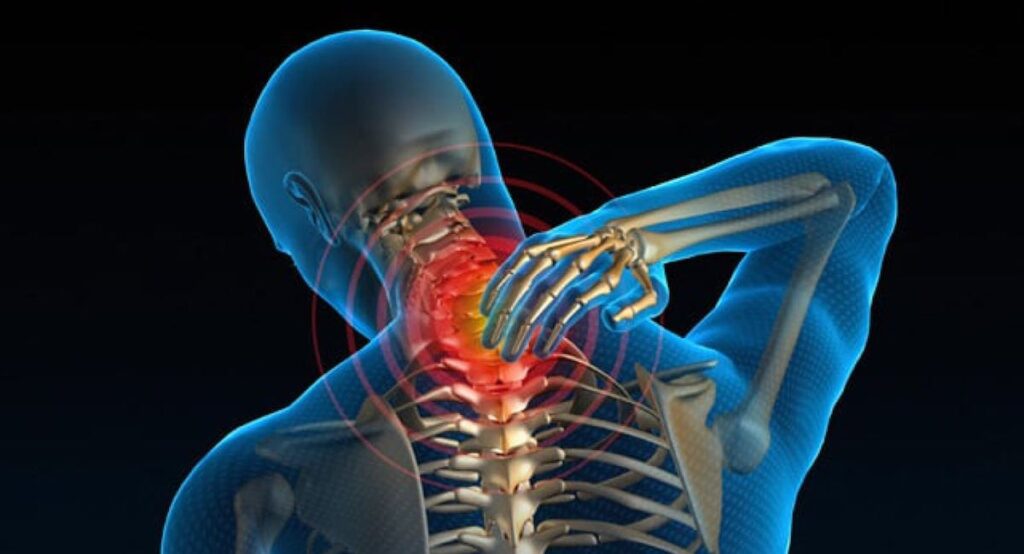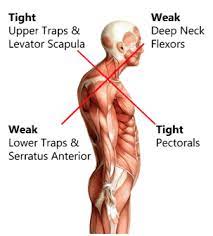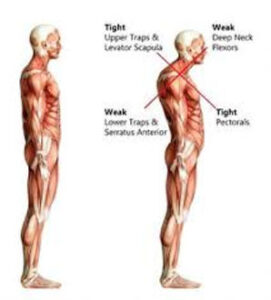

Welcome to the world of bad neck posture, where even your spine might want to complain about the constant abuse!
Today, we’ll discuss how poor neck posture can put a serious strain on your cervical muscles, causing not only discomfort but also potential long-term damage.
If you’ve ever wondered why a few hours of slouching can leave your neck screaming for relief, you’re in the right place.
Article Index:
- What is Poor Neck Posture?
- The Anatomy of Cervical Muscles
- How Neck Posture Leads to Muscle Strain
- Why Forward Head Posture is a Culprit
- Real-Life Example: A Day in the Life of Tech Neck
- The Role of Technology in Neck Strain
- Long-Term Effects on the Cervical Spine
- Scientific Evidence of Muscle Strain
- The Biomechanics of Bad Posture
- Conclusion: A Pain in the Neck (Literally)
What is Poor Neck Posture?
First things first: what exactly is poor neck posture?
Imagine you’re staring at your phone with your head craned forward like a curious turtle.
That’s a classic example of poor neck posture, also known as “bad neck posture.”
It happens when your head is positioned in front of your shoulders, causing your neck muscles to work overtime to hold up the weight of your head.
According to a study in The Journal of Physical Therapy Science, this misalignment is more common than you would think, thanks to our tech-heavy lifestyles.
The Anatomy of Cervical Muscles
Before we discuss how your neck ends up in a full-blown rebellion, let’s meet the overworked, underappreciated team that holds your head upright day after day.
Trapezius: The Trapeze Artist of Your Spine:
This broad, flat muscle spans from the base of your skull to the mid-back. It supports head posture, helps with shrugging, and stabilizes the shoulder blades. According to Clinical Biomechanics, the trapezius also compensates when deep neck stabilizers weaken—often leading to tension headaches and neck fatigue.
Levator Scapulae: The Tension Hoarder:
Running from the cervical vertebrae to the scapula, this muscle elevates the shoulder and assists in neck rotation. But when your head moves forward, it shortens and tightens, becoming a hotspot for chronic pain. A 2018 study in Muscle & Nerve found levator scapulae overactivity in patients with postural neck pain.
Sternocleidomastoid (SCM): The Neck’s Drama Queen:
This thick, rope-like muscle turns and flexes your head. Unfortunately, it is also quick to jump in when alignment goes south. In cases of forward head posture, the SCM becomes overactive, pulling the head further forward—a vicious cycle noted in Journal of Bodywork and Movement Therapies.
Don’t Forget the Deep Cervical Flexors (DCFs):
These small but mighty muscles (like longus capitis and longus colli) are crucial for spinal stability. When they weaken, bigger muscles like the trapezius and SCM step in and overcompensate, often poorly.
So yes, your cervical muscles are carrying a 12-pound weight all day. Treat them like royalty—or be ready for their revenge tour.
How Neck Posture Leads to Muscle Strain?
When your neck is in a forward position, it changes the natural curvature of your cervical spine.
The muscles in the back of your neck, especially the levator scapulae and trapezius, have to work harder to keep your head from drooping even further.
Over time, this extra effort causes muscle fatigue and strain.
Clinical Biomechanics published a study showing that forward head posture significantly increases the load on cervical muscles, leading to stiffness and discomfort.
Why Forward Head Posture is a Culprit?
Forward head posture (or FHP, if you want to sound fancy) is one of the main reasons for cervical muscle strain.
Each inch your head moves forward adds about 10 pounds of extra pressure on your neck muscles.
Dr. Kenneth Hansraj, a spine surgeon, found that tilting your head forward by just 15 degrees increases the weight on your neck to 27 pounds.
Imagine carrying a heavy bowling ball around all day—yikes!
A Day in the Life of Tech Neck
Let’s consider an everyday scenario.
Meet Emily, a software engineer who spends hours hunched over her laptop.
By the end of the day, her neck feels tight and sore.
This is classic “tech neck,” a condition caused by poor posture while using digital devices.
Emily’s muscles are strained because they are trying to hold her head up in a forward position for extended periods.
Sound familiar?
The Role of Technology in Neck Strain
We have officially entered the age of “tech neck”—and our cervical spines are not thrilled about it.
With smartphones in our palms, laptops on our laps, and tablets within reach, we are spending more time than ever hunched over screens.
According to The Journal of Ergonomics, the average smartphone user clocks in about 2 to 4 hours daily staring down at their device.
That is nearly 1,400 hours a year of spinal stress—and your neck muscles are picking up the tab.
As per BestForwardHeadPostureFix, this chronic downward gaze can exert as much as 60 pounds of pressure on the cervical spine, depending on the angle.
That is the equivalent of carrying a kindergartener on your neck all day—except you do not get hugs in return.
And it is not just the neck. This tech-induced slouch pulls on your shoulders, flattens your thoracic curve, and tightens chest muscles, creating a cascade of postural imbalances.
The result?
Muscle stiffness, dull aches, and long-term structural changes that can even affect breathing and focus.
So next time you are deep into your fourth hour of doom-scrolling, consider this: your body is keeping score.
Tech may be smart, but your posture should be smarter. Elevate your screens, take posture breaks, and give your neck a break before it taps out completely.
Long-Term Effects on the Cervical Spine
Unfortunately, the effects of poor neck posture are not limited to temporary discomfort.
Over time, it can lead to more severe conditions, like degenerative disc disease, herniated discs, and even nerve compression.
A study in Spine journal highlights how chronic forward head posture can accelerate the degeneration of cervical discs, making neck problems more difficult to treat.
Scientific Evidence of Muscle Strain
The link between poor posture and cervical muscle strain is well-documented.
For instance, research published in The Journal of Orthopedic & Sports Physical Therapy shows that poor posture weakens the deep cervical flexors and overworks the superficial neck muscles.
This muscle imbalance can lead to chronic pain and limited neck mobility.
The Biomechanics of Bad Posture
When your head is properly aligned, your cervical spine maintains a natural curve, allowing the surrounding muscles to function efficiently. However, poor posture disrupts this balance, leading to a series of musculoskeletal issues.
Here’s how:
Forward Head Posture (FHP) – Tilting your head forward shifts its weight ahead of the body’s centerline. This misalignment forces the posterior neck muscles to overexert themselves to support the head’s weight, leading to overstretching and fatigue. Meanwhile, the anterior neck muscles become shortened and tight. This imbalance creates a cycle of discomfort and stiffness. As per Dr. Erik Dalton, a pioneer in manual therapy, poor neck posture can lead to long-term musculoskeletal dysfunction.
Increased Cervical Load – For every inch the head moves forward, the weight the neck must support increases by approximately 10 pounds. This added strain flattens the natural cervical curve, putting abnormal pressure on muscles, ligaments, and vertebrae. Over time, this can lead to conditions like osteoarthritis. According to Dr. Erik Dalton’s research, excessive forward head posture places the cervical spine under chronic stress, increasing the likelihood of degenerative changes.
Upper Crossed Syndrome (UCS) – This condition is characterized by tight upper trapezius and levator scapulae muscles, paired with weak deep cervical flexors and lower trapezius muscles. UCS is commonly caused by prolonged poor posture, such as slouching at a desk or hunching over a smartphone. Dr. Erik Dalton explains that this muscle imbalance can lead to joint dysfunction in the cervical spine and shoulders, resulting in pain and restricted movement.
Addressing these postural issues through targeted exercises, ergonomic adjustments, and mindfulness can help restore proper alignment, alleviate discomfort, and prevent long-term complications. By making small changes in daily posture, you can protect your neck from unnecessary strain and improve overall well-being.
A Pain in the Neck (Literally)
In conclusion, poor neck posture is more than just an annoying habit—it is a blueprint for chronic muscle strain and long-term cervical spine problems.
When your head shifts forward from its natural alignment, it dramatically increases the load on your cervical spine—up to 60 pounds of force depending on the angle.
Over time, this leads to muscle fatigue, joint stress, and even nerve impingement that can radiate into the shoulders and arms.
Understanding how your posture affects your neck is the first—and arguably most powerful—step toward change.
According to research published by the Journal of Physical Therapy Science, poor posture is directly linked to reduced mobility and muscle dysfunction in the neck region. Fortunately, the fix doesn’t require complicated tools or drastic interventions.
Small, daily adjustments can yield big results. Keeping screens at eye level, practicing gentle chin tucks, and taking movement breaks every 30 to 60 minutes can help retrain your body into a healthier alignment.
Some physical therapists even recommend simple “tummy time” for adults—lying on your stomach for a few minutes daily to strengthen postural muscles.
So the next time you find yourself hunched over your phone or laptop, remember—your neck muscles are protesting in silence.
Listen to them. By being posture-aware and adopting a few smart habits, you can reduce strain, prevent long-term damage, and support your spine’s health for years to come.
As per the Cleveland Clinic and Harvard Health Publishing, even small improvements in posture can significantly enhance physical comfort and overall wellbeing.
References:

